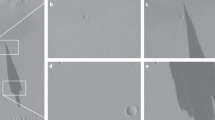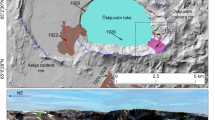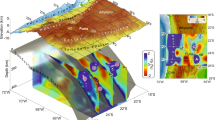Abstract
Large regions of the jovian moon Ganymede have been resurfaced, but the means has been unclear1,2. Suggestions have ranged from volcanic eruptions of liquid water3,4,5 or solid ice6 to tectonic deformation7,8,9, but definitive high-resolution morphological evidence has been lacking. Here we report digital elevation models of parts of the surface of Ganymede, derived from stereo pairs combining data from the Voyager and Galileo spacecraft, which reveal bright, smooth terrains that lie at roughly constant elevations 100 to 1,000 metres below the surrounding rougher terrains. These topographic data, together with new images that show fine-scale embayment and burial of older features10, indicate that the smooth terrains were formed by flooding of shallow structural troughs by low-viscosity water-ice lavas. The oldest and most deformed areas (the ‘reticulate’ terrains) in general have the highest relative elevations, whereas units of the most common resurfaced type—the grooved terrain—lie at elevations between those of the smooth and reticulate terrains. Bright terrain, which accounts for some two-thirds of the surface, probably results from a continuum of processes, including crustal rifting, shallow flooding and groove formation. Volcanism plays an integral role in these processes, and is consistent with partial melting of Ganymede's interior11,12.
This is a preview of subscription content, access via your institution
Access options
Subscribe to this journal
Receive 51 print issues and online access
$199.00 per year
only $3.90 per issue
Buy this article
- Purchase on SpringerLink
- Instant access to full article PDF
Prices may be subject to local taxes which are calculated during checkout



Similar content being viewed by others
References
McKinnon, W. B. & Parmentier, E. M. in Satellites (eds Burns, J. A. & Matthews, M. S.) 718–763 (Univ. Arizona Press, Tucson, 1986).
Squyres, S. W. & Croft, S. K. in Satellites (eds Burns, J. A. & Matthews, M. S.) 293–341 (Univ. Arizona Press, Tucson, 1986).
Shoemaker, E. M., Lucchitta, B. K., Plescia, J. B., Squyres, S. W. & Wilhelms, D. E. in Satellites of Jupiter (ed. Morrison, D.) 435–520 (Univ. Arizona Press, Tucson, 1982).
Parmentier, E. M., Squyres, S. W., Head, J. W. & Allison, M. L. The tectonics of Ganymede. Nature 295, 290–293 (1982).
Allison, M. L. & Clifford, S. M. Ice-covered water volcanism on Ganymede. J. Geophys. Res. 92, 7865–7876 (1987).
Kirk, R. L. & Stevenson, D. J. Thermal evolution of a differentiated Ganymede and implications for surface features. Icarus 69, 91–134 (1987).
Lucchitta, B. K. Grooved terrain on Ganymede. Icarus 44, 481–501 (1980).
Head, J. W., Pappalardo, R. T., Collins, G. & Greeley, R. Tectonic resurfacing on Ganymede and its role in the formation of grooved terrain. Lunar Planet. Sci. Conf. [CD-ROM] XXIX, 535 (1997).
Pappalardo, R. T. et al. Grooved terrain on Ganymede: First results from Galileo high-resolution imaging. Icarus 135, 276–302 (1998).
Kay, J. E. & Head, J. W. Geologic mapping of the Ganymede G8 Calderas region: Evidence for cryovolcanism. Lunar Planet. Sci. Conf. [CD-ROM] XXX, 1103 (1999).
Showman, A. P. & Malhotra, R. Tidal evolution into the Laplace resonance and the resurfacing of Ganymede. Icarus 127, 93–111 (1997).
Showman, A. P., Stevenson, D. J. & Malhotra, R. Coupled orbital and thermal evolution of Ganymede. Icarus 129, 367–383 (1997).
Zahnle, K., Dones, L. & Levison, H. F. Cratering rates on the Galilean satellites. Icarus 136, 202–222 (1998).
Schenk, P. M. & Moore, J. M. Volcanic constructs on Ganymede and Enceladus: Topographic evidence from stereo images and photoclinometry. J. Geophys. Res. 100, 19009–19022 (1995).
Head, J. W. et al. Cryovolcanism on Ganymede: Evidence in bright terrain from Galileo solid state imaging data. Lunar Planet. Sci. Conf. [CD-ROM] XXIX, 1666 (1998).
Moore, J. M. et al. Mass movement and landform degradation on the icy Galilean satellites: Results of the Galileo nominal mission. Icarus 140, 294–312 (1999).
Belton, M. J. S. et al. Galileo's first images of Jupiter and the Galilean satellites. Science 274, 377–385 (1996).
Collins, G. C., Head, J. W. & Pappalardo, R. T. Formation of Ganymede grooved terrain by sequential extensional episodes: Implications of Galileo observations for regional stratigraphy. Icarus 135, 345–359 (1998).
Giese, B. et al. The local topography of Uruk Sulcus and Galileo Regio obtained from stereo images. Icarus 135, 303–316 (1998).
Schenk, P. M. & Moore, J. M. Stereo topography of the south polar region of Mars: Volatile inventory and Mars Polar Lander landing site. J. Geophys. Res. 105, 24529–24546 (2000).
Schenk, P. M., Jones, K. & Fessler, B. The 400 meters: Stereo topographic mapping of the bright terrain-dark terrain boundary on Ganymede. Bull. Am. Astron. Soc. 28, 1074 (1996).
Wilhelms, D. E. Geologic map of the Osiris (Jg-12) and Apsu Sulci (Jg-13) Quadrangles of Ganymede. US Geol. Surv. Misc. Invest. Ser. Map I-2442 (1997).
Head, J. W. & Wilson, L. Lunar mare volcanism—Stratigraphy, eruption conditions, and the evolution of secondary crusts. Geochim. Cosmochim. Acta 56, 2155–2175 (1992).
Dombard, A. J. & McKinnon, W. B. Formation of grooved terrain on Ganymede: Extensional instability mediated by cold, superplastic creep. Icarus (submitted).
Acknowledgements
We thank K. Jones for image processing during the early phases of this project, L. Prockter and especially R. Kirk for comments on the manuscript, and NASA's Jovian Systems Data Analysis Program and the Planetary Geology & Geophysics Program for support.
Author information
Authors and Affiliations
Corresponding author
Rights and permissions
About this article
Cite this article
Schenk, P., McKinnon, W., Gwynn, D. et al. Flooding of Ganymede's bright terrains by low-viscosity water-ice lavas. Nature 410, 57–60 (2001). https://doi.org/10.1038/35065027
Received:
Accepted:
Issue Date:
DOI: https://doi.org/10.1038/35065027
This article is cited by
-
Volcanism in the Solar System
Science China Earth Sciences (2023)
-
Ice-Ocean Exchange Processes in the Jovian and Saturnian Satellites
Space Science Reviews (2020)
-
Fluid dynamic induced break-up during volcanic eruptions
Nature Communications (2019)
-
Cryovolcanic rates on Ceres revealed by topography
Nature Astronomy (2018)
-
Characteristics of Icy Surfaces
Space Science Reviews (2010)




